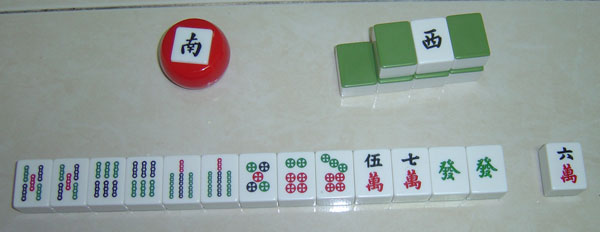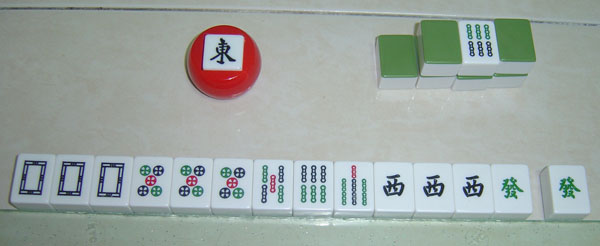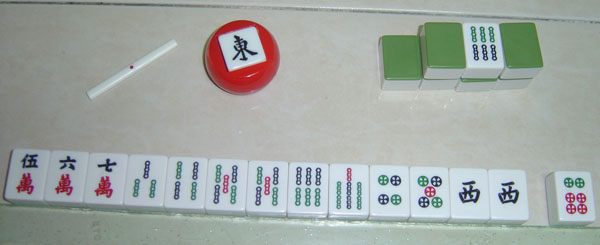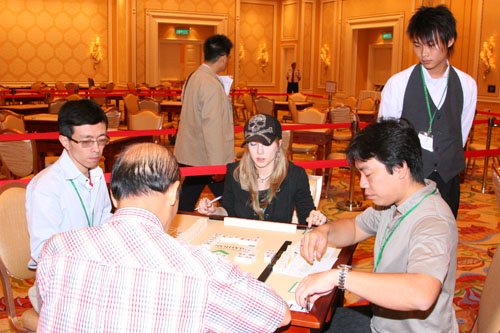September 22, 2007

In Garthe's Hands #15
Had a hard time deciding where to put today's column. It was originally just a response to Gemma's column, but then it was getting so long, it seemed like it might just be better to put it in with the columns. Hope I'm not stealing any of your thunder there, Gemma.
So the topic of course, is the All Pairs hand. I have certainly shared Gemma's frustration with it and have complained about its orneriness (ornerity? ornerosity?) quite a bit myself. To review, it's one of only 2 hands in Reach Mahjong which will not be of the normal form: 4 groups of 3 (runs or triples), plus a "head" or pair. This is one of the reasons that it's difficult to see when players are aiming for it and makes it something of a wild card in the Mahjong group of hands. A completed hand will simply be 7 pairs of different tiles. When I say different, I mean that it is unacceptable for 2 of the pairs to be the same tiles, in essence, a concealed quad remaining hidden in your hand. Personally I find this restriction a bit arbitrary and lame, but there it is. Here is an example of a finished hand:

It is surprising how hard it is to complete this hand despite how close one may seem in the beginning. I'll start thinking about it as a possibility with even just 2 or 3 pairs if a lot of the singles I have are outside or honors. And the road to 4 or 5 pairs is often very short. It's that 6th pair to make the hand ready, and the final tile to win that are the real problems. I'll always be waiting for something to match a tile already in the hand so at best I have 3 possibilities for each one of those singles. Let's think about it in terms of how many tiles are available and maybe it will become clear why these last tiles are such big hurdles. If I had just a Peace hand that was one away from ready with two open ended waits, there would be 16 possible tiles that make the hand ready. When my All Pairs hand is one away from ready, I'll have 3 singles waiting to pair up meaning that at best, there are only 9 tiles that could possibly make the hand ready. When I get to ready, that Peace hand is going to have 8 possible tiles for the win and the All Pairs will only have 3. (Of course these numbers will be affected by what's already out on the board but for this situation let's just think of the optimal numbers) So from the get go we know that All Pairs is going to be a harder than normal hand to complete.
So the now the issue: how best to work it into your game. If it's going to be a harder hand to complete, the reward for completing it should be greater too right? How to make it pay off? The most important thing is going to be finding the right tile to wait on, but let's start with one of the other decisions you'll have to make first, namely whether to go for All Triples or All Pairs. Factors affecting this decision will be what kind of pairs are already in the hand, if any of them are triples already, and whether any of them are Lucky Dragons (dora). If I already have 4 pairs with one of the pairs being lucky dragons, I'm going to be a lot more proactive about winning the hand, probably bumping (ponning) tiles the first chance I get and sending myself off in the All Triples direction. If my pairs are more towards the middle, I might consider the fact that other people are probably going to be using those tiles and no matter how long I wait, I may never have a chance to bump them. I tend to dream big, so as soon as one of my pairs becomes a triple, I'm already starting to think about 3 or even 4 Concealed Triples. That silly dream is why I personally end up going for All pairs more because I opt not to bump tiles when they first come out, hoping that I'll draw the last remaining one for the chance at the limit hand. Another big benefit of keeping my hand concealed is that I can Reach when it's ready, and in most games, Reaching allows me a chance at the Hidden Lucky Dragon (Ura-dora) too. My little 1600 pointer can turn into 8000 pretty quickly with a lucky turn there or even become 12000 if I manage to draw it myself. Lots of points to think about and we still haven't even gotten to putting the hand together yet.
So let's say the decision has been made to go for All Pairs. Now we want tiles in our hand that other people are not likely to be using: honors and the end tiles and especially, tiles on the outer side of pairs in our hand. In Reach Mahjong there is a defensive term called a "wall". a “wall” is when all 4 of one tile towards the end (2s, 3s, 7s and 8s) are showing, making the end tiles (1s, 2s, 8s and 9s) unusable in runs and also seemingly safe to discard. This concept of a "wall" is very useful in many situations, one of which being here, when we want tiles that other people can't use. For example, if we have a 3 of dots pair in our hand and can see another 1or 2 of them on the board, we know it's going to be difficult for other players to use the 1 and 2 of dots. We can more reasonably expect those tiles to come out or possibly still be in the deck if they're not already out on the board. Also, when things get dangerous because someone has Reached or someone may be quietly Ready to win without Reaching, these tiles will be useful as safe discards.
Finally when we have to decide on our "wait", there are two things to think about. First, same as before, we want to choose something that people are not likely to be using. Second, especially if we decide to Reach, it may be useful to set a trap. Not only is the 1 of dots probably a good wait anyway, but it looks especially safe to other players if there is a 4 of dots in our discards. Remember the Missed Win Rule (Sacred Discard) prohibits winning not only on a tile that we've already discarded, but also on any tile if any of the winning tiles has been discarded. Because players tend to aim for open-ended waits, any tile 3 above or below a tile in our discards will look a little safer to players looking for something safe to discard. So another example would be choosing to wait on the 8 of bamboos because we have a 5 of bamboos in our discards. This defensive concept is called Piano Keys. The idea is, opened ended waits always consist of a combination of 1-4-7, 2-5-8 or 3-6-9, meaning that a 4, 5 or 6 in a player’s discard makes 1 and 7, 2 and 8 or 3 and 9, seem safe, respectively.
As always, working more Hand points into a hand is the best way to make it really pay off. However, a lot of the standard "extra" hands won't be an option with All Pairs. Obviously, anything using runs or triples is out. Sometimes All Simples will be an option, but I tend not to aim for it because middle tiles tend to be more useful for other players. Remember, we want tiles that are NOT useful for other players. Also, a bunch of middle tiles are probably just going to end up falling into runs and it'll be easier to make it a pay off with a Reach/Simples/Peace combination. A Half Flush combined with All Pairs also seems to often come close but it's much harder than it looks to finish. Usually, something will pair up in another suit, and then that has to be discarded, but then everyone notices that a pair of something came out of my hand and then NO one discards anything from the suit not in my discards. So the best way for me to get lots of points out of it tends to be saving those garbage tiles that nobody wants and trying to make one of the pairs the Lucky Dragon (dora).
Looking at my stats on Mahjong Fight Club (Konami), it's definitely in the a-little-short-of-major category, occurring with slightly less frequency than 3 Colored Runs. If you find you go several games without finishing this hand once, you shouldn't actually find that too surprising. However it is harder for other players to read and it's possible for it to turn into a monster with a little luck so you should try working it into your game. The opportunities will come.
Let's get people's opinions. What would you do in the following situations and why?
South seat, 3rd hand of East round, 3000 points out of first place, 5th draw, Lucky Dragon (dora) is 9 of Dots

East Seat, 4th hand of South round, 4000 points out of first place, 5th draw, Lucky dragon (dora) is 8 of Bams
West seat discards 4-Grands(Cracks)

East seat, 3rd hand of East round, even with Dealer in first place, 5th draw, Lucky dragon (dora) is 6 of Dots
North Seat discards the first Red Dragon

Remember, no right or wrong answers so give em a shot.
 Reach Mahjong (RM) first opened in December of 2006 as a website devoted to the Japanese style of Riichi Mahjong. Upon opening, RM had 3 regular columns written by professional Mahjong players Jenn Barr and Garthe Nelson and the third written by Jenn’s student of the game, Gemma Collinge. The site included rules explanations, articles about newsworthy events in Japan and beyond, links to important Mahjong websites and interviews with professional players. Some important coverage included this year’s World Series of Mahjong and Open European Mahjong Championship. In its inaugural year, RM is already known worldwide as the best English source for Reach/Riichi strategy and many new players that have emerged this year have admitted to learning all they know from RM.
Reach Mahjong (RM) first opened in December of 2006 as a website devoted to the Japanese style of Riichi Mahjong. Upon opening, RM had 3 regular columns written by professional Mahjong players Jenn Barr and Garthe Nelson and the third written by Jenn’s student of the game, Gemma Collinge. The site included rules explanations, articles about newsworthy events in Japan and beyond, links to important Mahjong websites and interviews with professional players. Some important coverage included this year’s World Series of Mahjong and Open European Mahjong Championship. In its inaugural year, RM is already known worldwide as the best English source for Reach/Riichi strategy and many new players that have emerged this year have admitted to learning all they know from RM.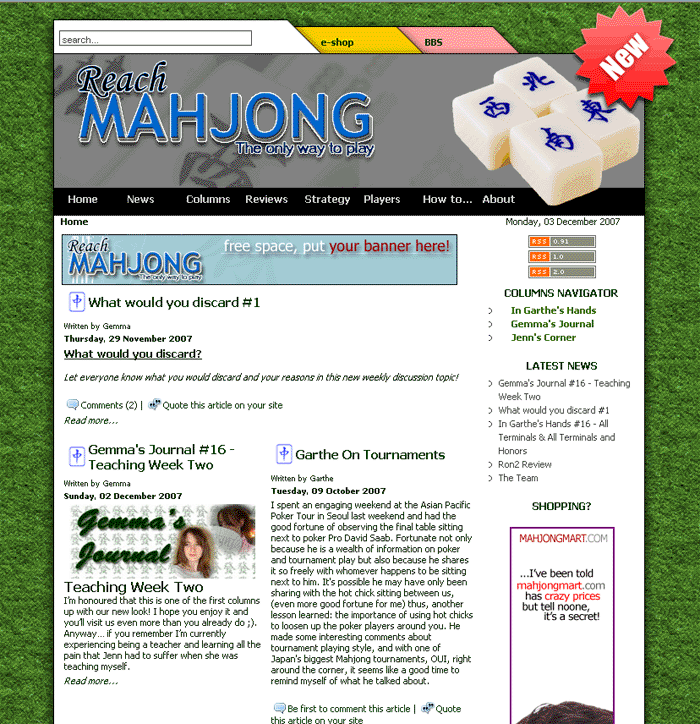 The new Reach Mahjong: The Only Way to Play has kept all the great columns from the first year and has added a great new line-up for the second year. Jenn Barr has maintained her leading role overseeing everything that goes on the site while Yakitori Online forums founder Andy Barzhagi has joined the team as the IT specialist and official blogger. In addition to Andy’s blog which is expected to start within a few days of opening, RM has added a weekly “What would you discard” question updated by Gemma Collinge which provides space for readers to leave comments and discuss discards of certain hands and a section for book reviews. An official Ron2 tutorial (the online game endorsed by the Japan Professional Mahjong League), the world’s first Mahjong Podcasts and a new glossary, more comprehensive than before will be added later this month. With the new content management system, RM updates are expected to be much more timely than before, bringing the world not only the best English strategic information on the game, but bringing it to you fast.
The new Reach Mahjong: The Only Way to Play has kept all the great columns from the first year and has added a great new line-up for the second year. Jenn Barr has maintained her leading role overseeing everything that goes on the site while Yakitori Online forums founder Andy Barzhagi has joined the team as the IT specialist and official blogger. In addition to Andy’s blog which is expected to start within a few days of opening, RM has added a weekly “What would you discard” question updated by Gemma Collinge which provides space for readers to leave comments and discuss discards of certain hands and a section for book reviews. An official Ron2 tutorial (the online game endorsed by the Japan Professional Mahjong League), the world’s first Mahjong Podcasts and a new glossary, more comprehensive than before will be added later this month. With the new content management system, RM updates are expected to be much more timely than before, bringing the world not only the best English strategic information on the game, but bringing it to you fast.















